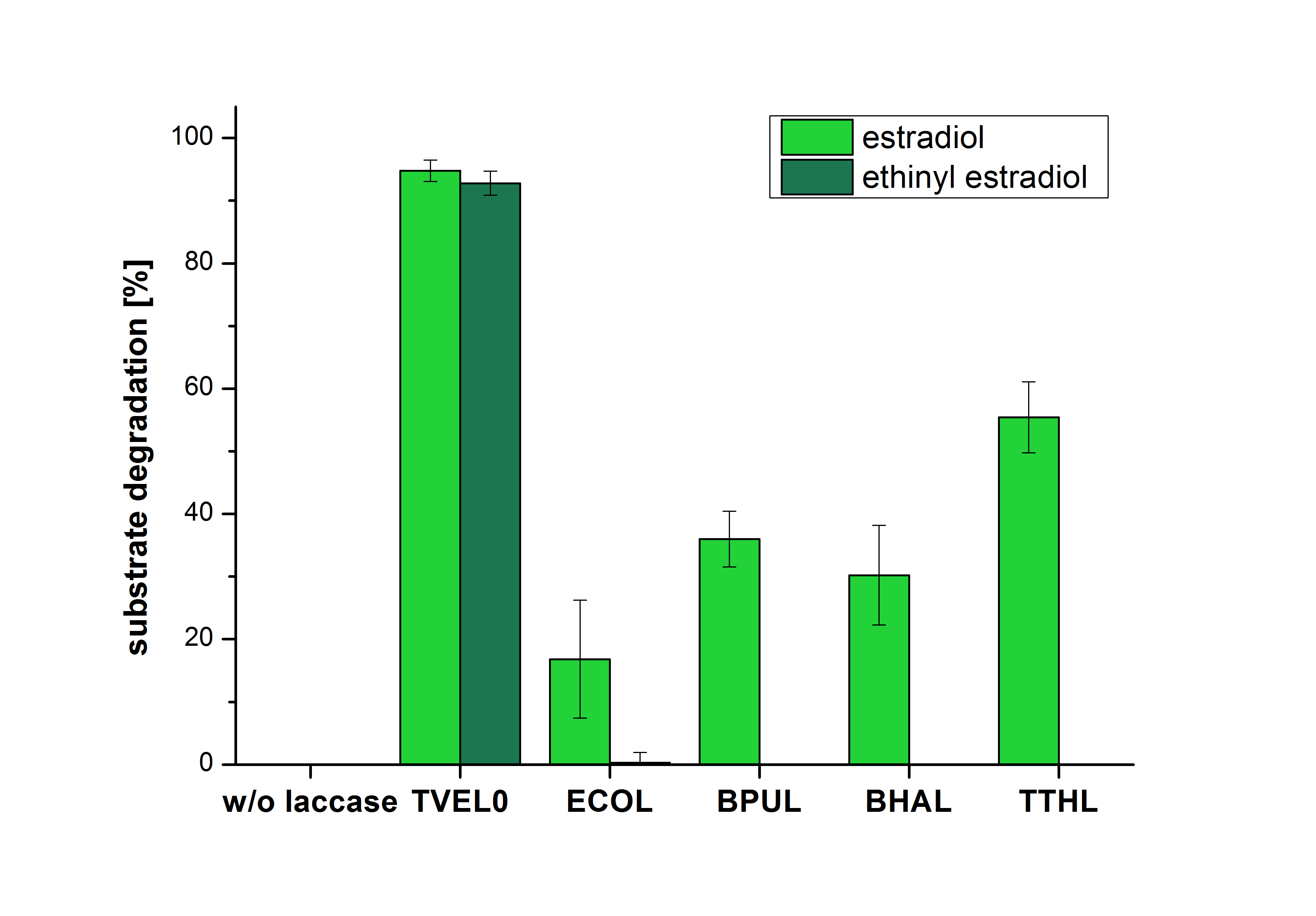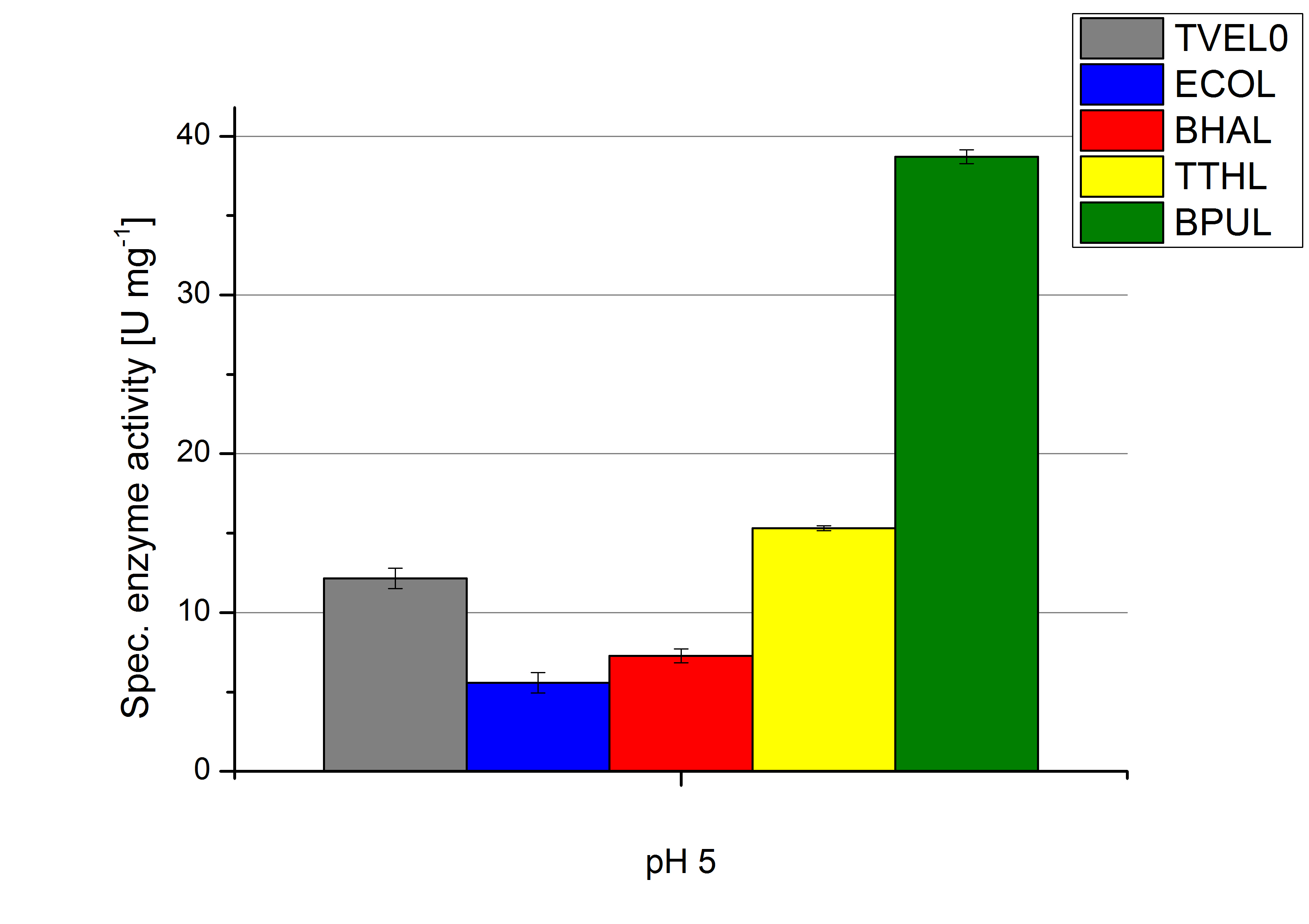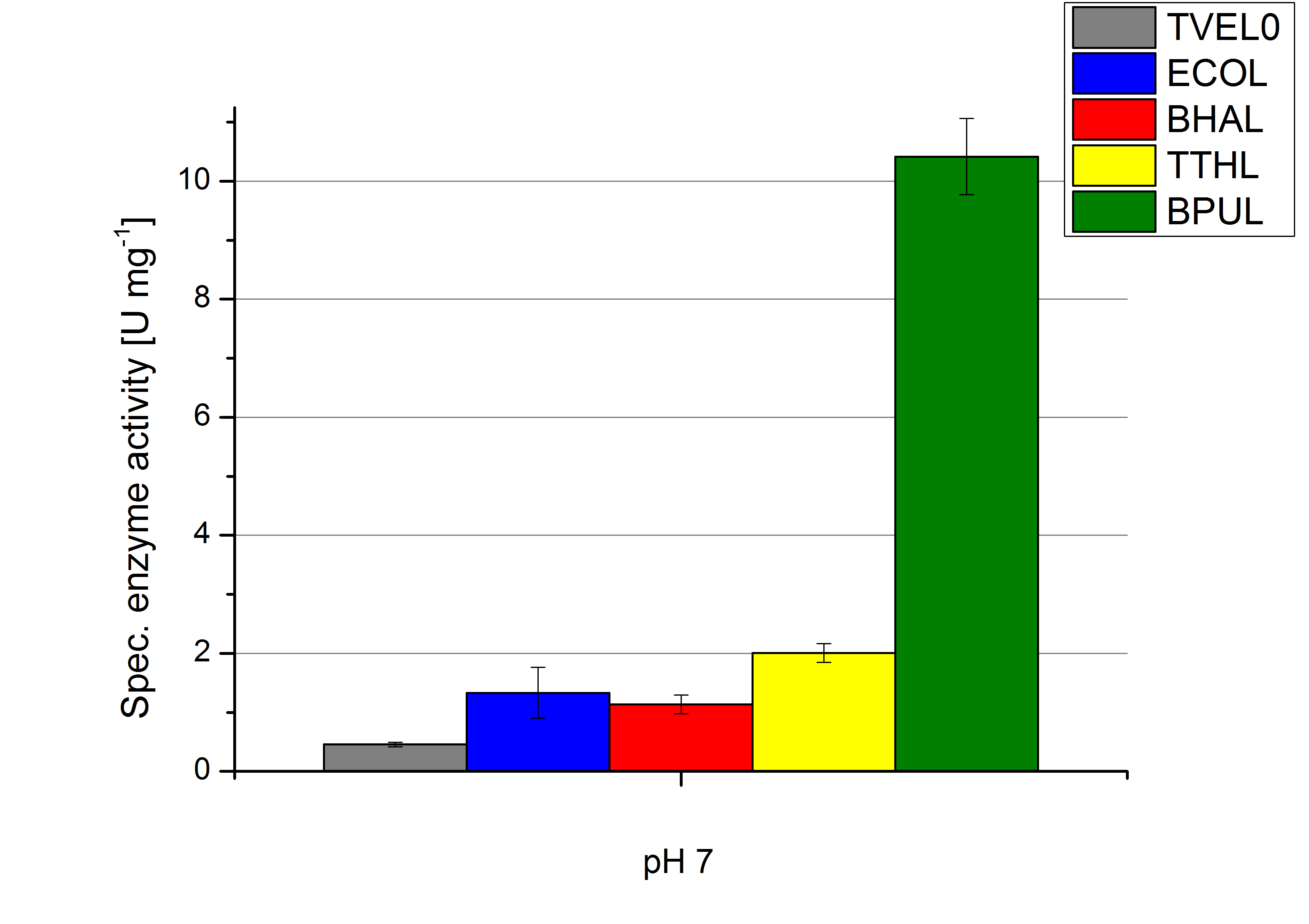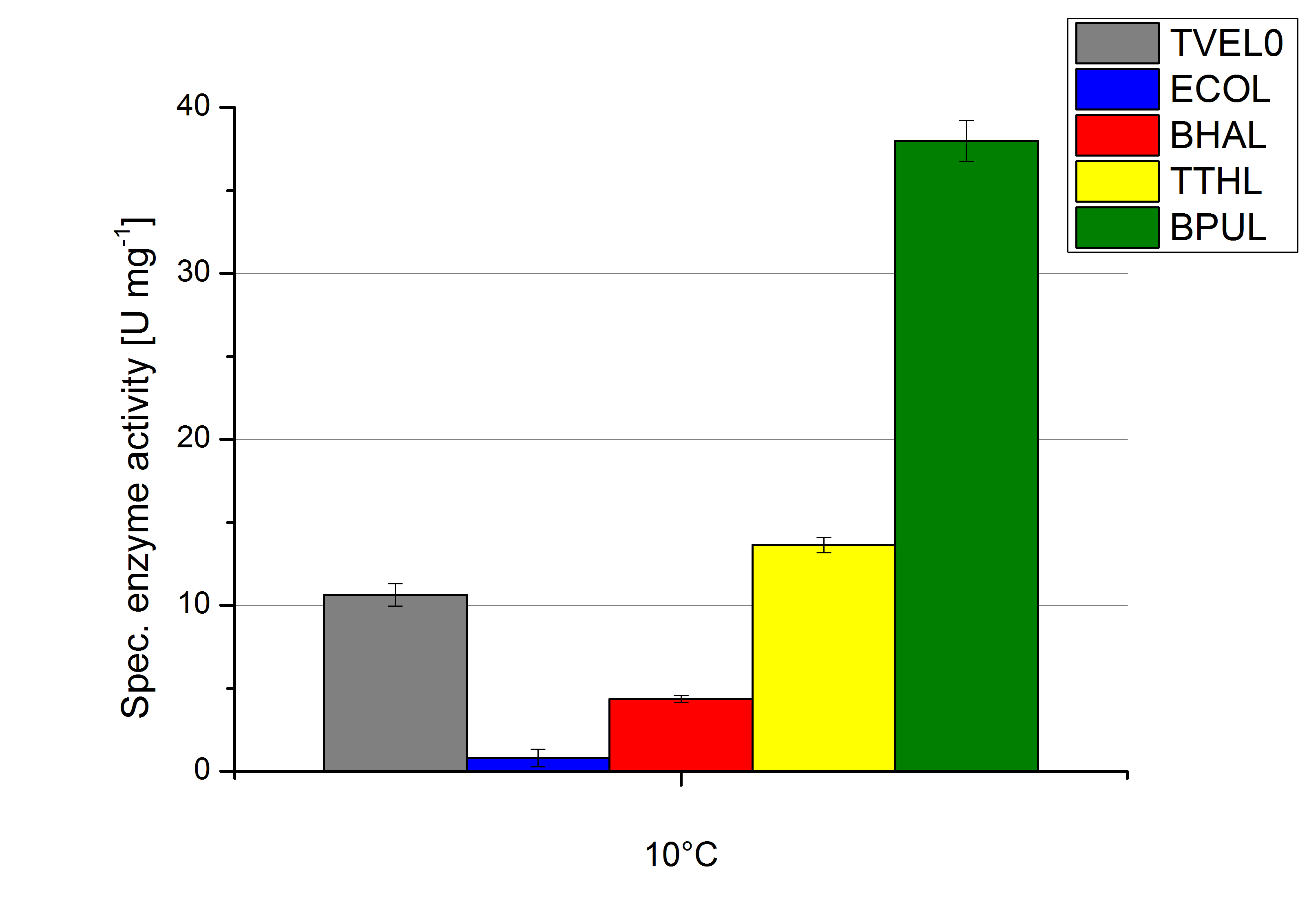Team:Bielefeld-Germany/Results/comparison
From 2012.igem.org
(→Activity Test) |
(→Activity Test) |
||
| Line 14: | Line 14: | ||
=== Activity Test === | === Activity Test === | ||
| - | [[File:Bielefeld2012 pH5 comparison.jpg|left|200px|Comparison of our produzed enzymes and TVEL0 regarding their activity in a pH of 5. BPUL clearly shows the highest specific enzyme activity of 38 U mg< | + | [[File:Bielefeld2012 pH5 comparison.jpg|left|200px|Comparison of our produzed enzymes and TVEL0 regarding their activity in a pH of 5. BPUL clearly shows the highest specific enzyme activity of 38 U mg<sup>-1</sup>.]] |
| - | [[File:Bielefeld2012 pH7 comparison.jpg|right|200px|Comparison of our produzed enzymes and TVEL0 regarding their activity in a pH of 7. BPUL clearly shows the highest specific enzyme activity of 11 U mg< | + | [[File:Bielefeld2012 pH7 comparison.jpg|right|200px|Comparison of our produzed enzymes and TVEL0 regarding their activity in a pH of 7. BPUL clearly shows the highest specific enzyme activity of 11 U mg<sup>-1</sup>.]] |
To optimize the application of our enzymes in a waste water treatment plant the obtained results were compared and further analyzed. All laccases show an optima at pH 5. However BPUL distinguishes from the other enzymes by showing a signigicantly higher enzyme activity. At pH 7 respectively the maximal activity is as well seen in the BPUL sample. At pH 5 ECOL, BPUL, BHAL, TTHL and TVEL0 show an average activity of 10-15 U mg<sup>-1</sup>. Though at pH 7 the enzymes activities were calculated to not exceed 2 U mg<sup>-1</sup>, respectively. This indicates that at pH values of around 7 BPUL is the best choice for our filter and if other enzymes are desired or needed an higher amount has to be used. | To optimize the application of our enzymes in a waste water treatment plant the obtained results were compared and further analyzed. All laccases show an optima at pH 5. However BPUL distinguishes from the other enzymes by showing a signigicantly higher enzyme activity. At pH 7 respectively the maximal activity is as well seen in the BPUL sample. At pH 5 ECOL, BPUL, BHAL, TTHL and TVEL0 show an average activity of 10-15 U mg<sup>-1</sup>. Though at pH 7 the enzymes activities were calculated to not exceed 2 U mg<sup>-1</sup>, respectively. This indicates that at pH values of around 7 BPUL is the best choice for our filter and if other enzymes are desired or needed an higher amount has to be used. | ||
| - | [[File:Bielefeld2012 comparison Temp Units.jpg|left|200px|Comparison of our produzed enzymes and TVEL0 regarding their activity at 10°C. BPUL clearly shows the highest specific enzyme activity of 37 U mg< | + | [[File:Bielefeld2012 comparison Temp Units.jpg|left|200px|Comparison of our produzed enzymes and TVEL0 regarding their activity at 10°C. BPUL clearly shows the highest specific enzyme activity of 37 U mg<sup>-1</sup>.]] |
Regarding the temperature characterizations BPUL is observed to show an enzyme activity of 37 U mg<sup>-1</sup>. ECOL, BPUL, BHAL, TTHL and TVEL0 show an activity of 2 to 13 U mg<sup>-1</sup>. Thus BPUL and also TTHL are very feasible for an application even in cold environments. For a usage of BHAL and ECOL a longer incubation time of the laccases and the substrates needs to take place to ensure a proper degradations of microcontaminents. | Regarding the temperature characterizations BPUL is observed to show an enzyme activity of 37 U mg<sup>-1</sup>. ECOL, BPUL, BHAL, TTHL and TVEL0 show an activity of 2 to 13 U mg<sup>-1</sup>. Thus BPUL and also TTHL are very feasible for an application even in cold environments. For a usage of BHAL and ECOL a longer incubation time of the laccases and the substrates needs to take place to ensure a proper degradations of microcontaminents. | ||
<br><br> | <br><br> | ||
Revision as of 00:55, 27 October 2012

Activity Test
To optimize the application of our enzymes in a waste water treatment plant the obtained results were compared and further analyzed. All laccases show an optima at pH 5. However BPUL distinguishes from the other enzymes by showing a signigicantly higher enzyme activity. At pH 7 respectively the maximal activity is as well seen in the BPUL sample. At pH 5 ECOL, BPUL, BHAL, TTHL and TVEL0 show an average activity of 10-15 U mg-1. Though at pH 7 the enzymes activities were calculated to not exceed 2 U mg-1, respectively. This indicates that at pH values of around 7 BPUL is the best choice for our filter and if other enzymes are desired or needed an higher amount has to be used.
Regarding the temperature characterizations BPUL is observed to show an enzyme activity of 37 U mg-1. ECOL, BPUL, BHAL, TTHL and TVEL0 show an activity of 2 to 13 U mg-1. Thus BPUL and also TTHL are very feasible for an application even in cold environments. For a usage of BHAL and ECOL a longer incubation time of the laccases and the substrates needs to take place to ensure a proper degradations of microcontaminents.
Immobilization
Substrate Analysis
The measurements were made to test if the produced laccases were able to degrade different hormones. Therefore the produced laccases were inserted in the same concentrations (3 µg mL-1) to the different measurement approaches. To work with the correct pH value (which were measured by the Team Activity Test) Britton Robinson buffer at pH 5 was used for all measurements. The initial substrate concentration was 5 µg mL-1. The results of the reactions without ABTS are shown in Figure 2. On the Y-axis the percentages of degraded estradiol (blue) and ethinyl estradiol (red) are indicated. The X-axis displays the different tested laccases. The degradation was measured at t0 and after five hours of incubation at 30 °C. The negative control was the substrate in Britton Robinson buffer and showed no degradation of the substrates. The bought laccase TVEL0 which is used as positive control is able to degrade 94.7 % estradiol and 92.7 % ethinyl estradiol. The laccase BPUL (from Bacillus pumilus) degraded 35.9 % of used estradiol after five hours. ECOL was able to degrade 16.8 % estradiol. BHAL degraded 30.2 % estradiol. The best results were determined with TTHL (laccase from Thermus thermophilus). Here the percentage of degradation amounted 55.4 %.
The results of the reactions of the laccases with addition of ABTS are shown in Figure 3. The experimental set ups were the same as the reaction approach without ABTS described above. The X-axis displays the different tested laccases. On the Y-axis the percentages of degraded estradiol (blue) and ethinyl estradiol (red) are shown. The degradation was measured at t0 and after five hours of incubation at 20 °C. The negative control showed no degradation of estradiol. 6.8 % of ethinyl estradiol was decayed. The positive control TVEL0 is able to degrade 100 % estradiol and ethinyl estradiol. The laccase BPUL (from Bacillus pumilus) degraded 46.9 % of used estradiol after ten minutes incubation. ECOL was able to degrade 6.7 % estradiol. BHAL degraded 46.9 % estradiol. With TTHL (laccase from Thermus thermophilus)a degradation 29.5 % were determined.


| 55px | | | | | | | | | | |
 "
"








